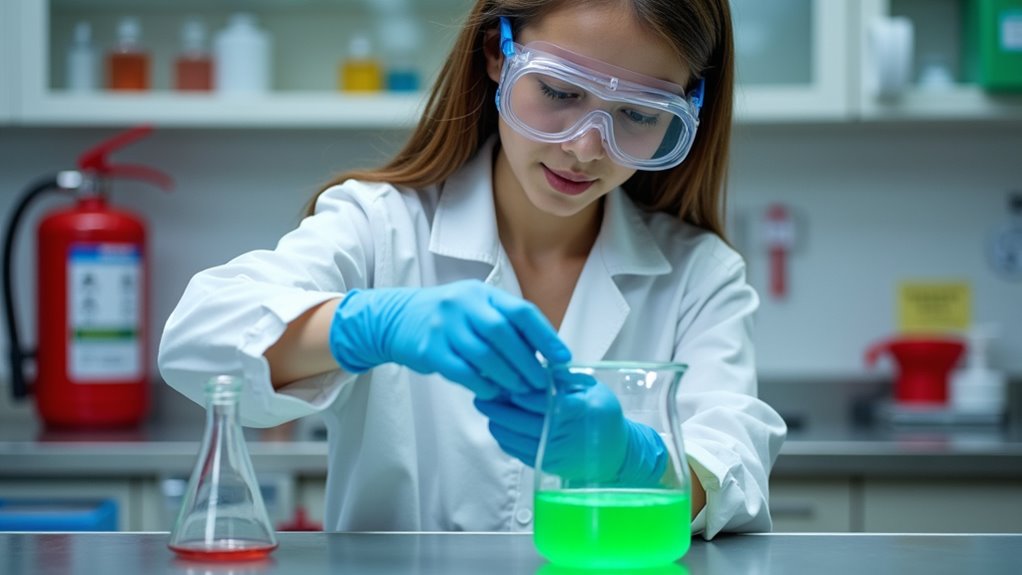To guarantee lab safety, follow all guidelines, wear proper PPE, and keep your space organized. Know where emergency equipment is and how to respond to spills or fires. Handle chemicals carefully, label everything, and dispose of hazardous materials properly. Regularly review procedures and conduct safety assessments to spot hazards early. Establish clear reporting systems and foster a safety-first culture. Keep informed on safety standards to maintain a secure lab environment—more detailed tips await as you continue.
Key Takeaways
- Understand and follow all lab safety guidelines, including emergency procedures and hazard signage.
- Properly select, use, and maintain PPE such as gloves, goggles, and lab coats.
- Keep the lab environment organized, clean, and properly labeled to prevent accidents.
- Handle chemicals with care, using fume hoods and correct disposal methods.
- Be prepared for emergencies with response plans, safety equipment, and regular training.
Understanding and Following Lab Safety Guidelines

Understanding and following lab safety guidelines is essential to guarantee a safe working environment. You need to know the locations of emergency equipment like fire extinguishers and safety showers, so you’re prepared during emergencies. Familiarize yourself with evacuation routes to exit quickly if needed. Proper chemical handling and disposal are critical to prevent accidents, and always pay attention to signage and labels on hazardous materials. Regular training sessions help you stay updated on safety policies and procedures. By understanding these guidelines, you minimize risks and ensure compliance with safety standards. Remember, safety isn’t just about rules—it’s about protecting yourself and your colleagues. Being informed and vigilant makes the lab a safer space for everyone. Prioritize safety at all times to prevent accidents and injuries. Knowing hazards of materials and understanding how to handle chemicals safely reduce the likelihood of incidents and ensure a safer lab environment. Additionally, understanding the biological impacts of substances can help prevent inadvertent exposure to harmful agents.
Personal Protective Equipment (PPE): Choosing and Using It Correctly
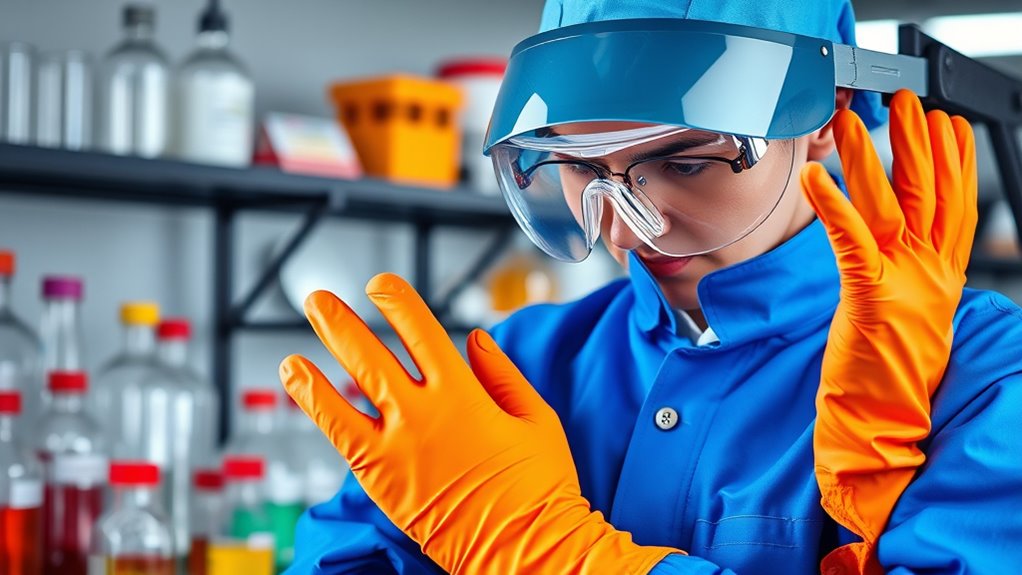
Once you’re familiar with lab safety guidelines and emergency procedures, selecting the right Personal Protective Equipment (PPE) becomes your next critical step. You need to choose gear like lab coats, aprons, and coveralls to shield against chemical and biological hazards. Safety glasses and goggles protect your eyes from splashes, while gloves should match the specific hazard—chemical, biological, or sharp objects. Closed-toe shoes or boots are essential to guard your feet from spills and falling objects. In high-risk situations, face shields add extra face protection. Remember, PPE must be appropriate for the hazard you face and properly maintained. Regular inspections, correct storage, and adherence to cleaning and disposal guidelines ensure your PPE stays effective and safe to use. The selection of PPE should be guided by a thorough hazard assessment, ensuring you have the right equipment for any potential risks encountered in the lab. Proper training is crucial for correct usage. Additionally, understanding PPE compliance can help prevent accidents and ensure safety protocols are followed effectively.
Emergency Preparedness and Response Procedures
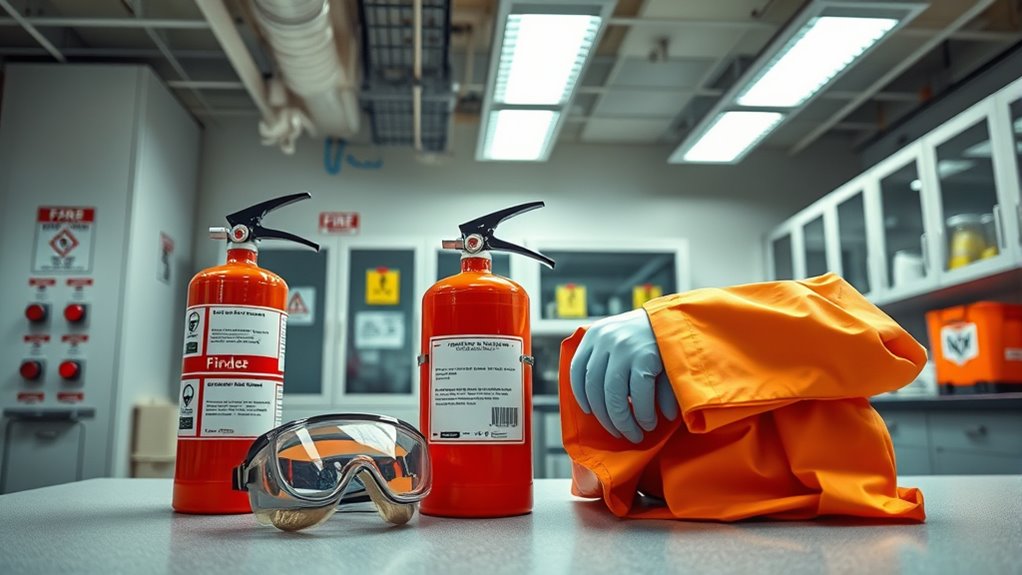
Are you prepared to handle emergencies in the lab effectively? You need to identify potential incidents like chemical spills or fires and involve all lab personnel in planning. Developing specific response plans for each scenario, and regularly training everyone on procedures, helps ensure swift and coordinated action. Establish clear communication protocols so alerts reach everyone quickly, minimizing confusion during an emergency. Prepare response kits with essential supplies, including first aid materials and spill containment tools, and conduct practice drills to stay ready. Secure hazardous materials properly according to safety guidelines, and have protocols for powering down equipment safely to prevent escalation. In emergencies, implement alert systems, follow shut-down procedures, and evacuate using designated routes. Ensure access to first aid supplies and know how to respond to fires. Regular training and preparedness are vital in reducing risks and ensuring everyone’s safety and quick recovery when incidents happen. Additionally, understanding lab safety procedures and adhering to them can significantly mitigate the severity of accidents.
Maintaining a Safe and Organized Laboratory Environment

Maintaining a safe and organized laboratory environment is essential for preventing accidents and ensuring smooth operations. Keep your workbench tidy to reduce clutter and contamination risks. Use labeled containers and cabinets to separate materials by type and hazard, making retrieval quick and safe. Regularly clean work surfaces with appropriate disinfectants to eliminate residues and biohazards. Proper storage of chemicals and equipment reduces the risk of spills and accidents, which is crucial for maintaining safety standards. Implementing automation technologies in lab procedures can further enhance safety by minimizing human error. Follow a routine schedule for cleaning, equipment maintenance, and waste disposal to maintain hygiene standards. Promptly clean up spills with established protocols to prevent slips, chemical reactions, or exposure. Before use, inspect all equipment for defects, store it properly away from chemicals and heat, and label it clearly. These practices help create a safe, efficient, and clean laboratory environment for everyone.
Proper Handling and Disposal of Chemicals and Hazardous Materials

Handling and disposing of chemicals and hazardous materials safely is essential to prevent accidents and protect personnel. Always wear appropriate PPE, including chemical splash goggles, disposable gloves, and full-length lab coats or chemical-resistant aprons. Proper handling reduces exposure risks. Match glove materials to chemical compatibility, and remove gloves before leaving the lab. Use fume hoods verified for airflow, and keep hood sashes at the recommended height. Store chemicals separately by hazard class, label containers with dates, and use grounding straps during flammable transfers. For waste, keep leak-proof containers in designated satellite areas, segregate organic and inorganic streams, and complete hazardous waste manifests when transporting off-site. Maintain spill kits nearby, and follow strict protocols to ensure chemicals are handled and disposed of without risk, keeping everyone safe. Additionally, understanding the Gold IRA regulations can help ensure compliance when disposing of precious metal investments.
Developing and Updating Standard Operating Procedures (SOPs)
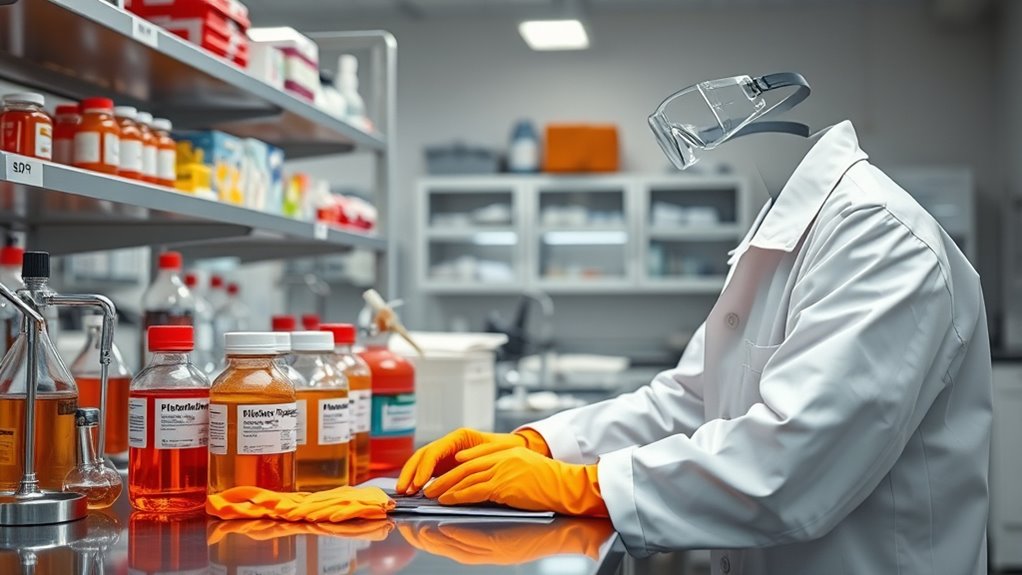
Developing and updating Standard Operating Procedures (SOPs) is vital for ensuring consistent and safe laboratory practices. You should create SOPs with clear, detailed instructions that cover all steps of procedures, including hazard identification and safety precautions. Incorporating safety and health considerations when handling hazardous chemicals is essential to protect personnel and the environment. Involving experienced lab personnel and supervisors guarantees accuracy and relevance, while safety officers review for compliance. When drafting SOPs, use straightforward language, add visual aids if necessary, and organize content logically with headings and numbered steps. Regularly review and revise SOPs to reflect changes in procedures, equipment, or regulations. Document all updates with version control, and communicate revisions clearly. Effective communication of SOP updates ensures that all staff are informed and adhere to current safety protocols. Training lab staff on SOPs before they perform procedures is indispensable for maintaining safety and compliance over time.
Monitoring and Improving Lab Safety Through Regular Assessments
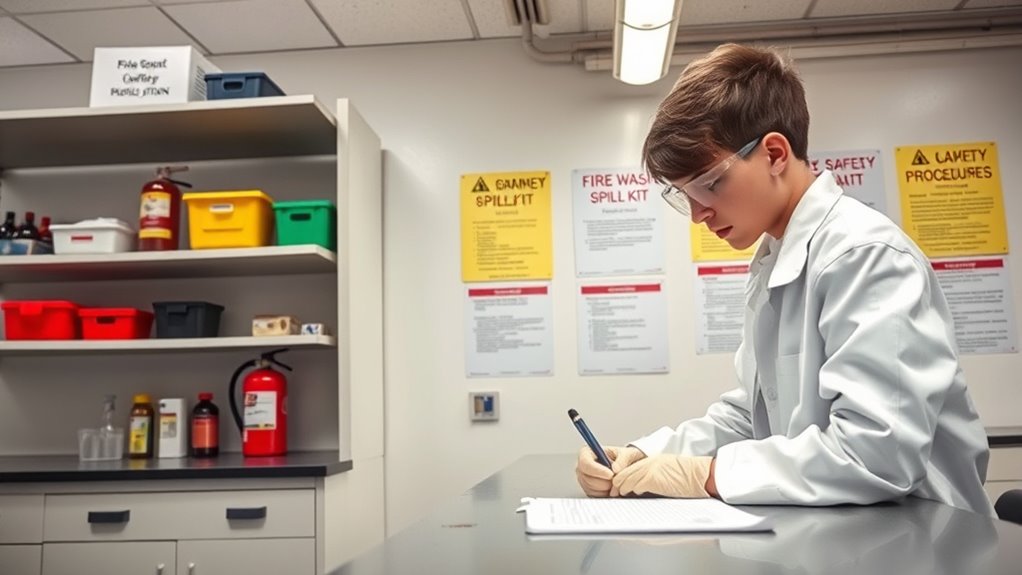
Regular assessments are key to guaranteeing your lab stays compliant with safety regulations and provides a secure environment for everyone. Typically conducted yearly, these evaluations include visual inspections, staff consultations, and addressing safety concerns promptly. A focus on vibrational energy can also enhance overall safety by fostering a positive and alert mindset among team members. Digital tools like SciShield streamline the process, helping you manage records and assessments efficiently. Your lab safety team plays a crucial role by guiding risk evaluations and assisting in mitigating safety issues. Regular assessments help identify hazards early, such as expired chemicals or unsafe procedures, allowing you to remove hazards and update safety measures. They also promote accountability and foster a safety-conscious culture.
Establishing and Using Safety Reporting Systems

Establishing an effective safety reporting system is essential for maintaining a safe laboratory environment, as it encourages you to promptly identify and communicate hazards. Use digital tools like online portals or apps to streamline incident reports, making submission quick and simple. QR codes can direct users to reporting platforms, as seen in Yale University’s Chemistry Department. Assure your system complies with standards like ISO 15189 and ISO/IEC 17025 for medical and testing labs. Make it user-friendly to boost participation and include features like photo uploads, detailed descriptions, and clear guidelines. Regular follow-up investigations and corrective plans help prevent recurrence. Incorporating Laboratory Operating Hours information can help coordinate safety procedures effectively. Here’s a quick overview:
| Feature | Purpose | Benefit |
|---|---|---|
| Incident Reports | Capture hazards and incidents | Improve safety response |
| Photo Uploads | Visual evidence of issues | Clarify concerns |
| User-Friendly Design | Encourage reporting | Broader participation |
| Data Management Software | Track and organize reports | Ensure compliance and analysis |
| Follow-Up Actions | Resolve and prevent hazards | Continuous safety improvement |
Fostering a Culture of Safety and Accountability
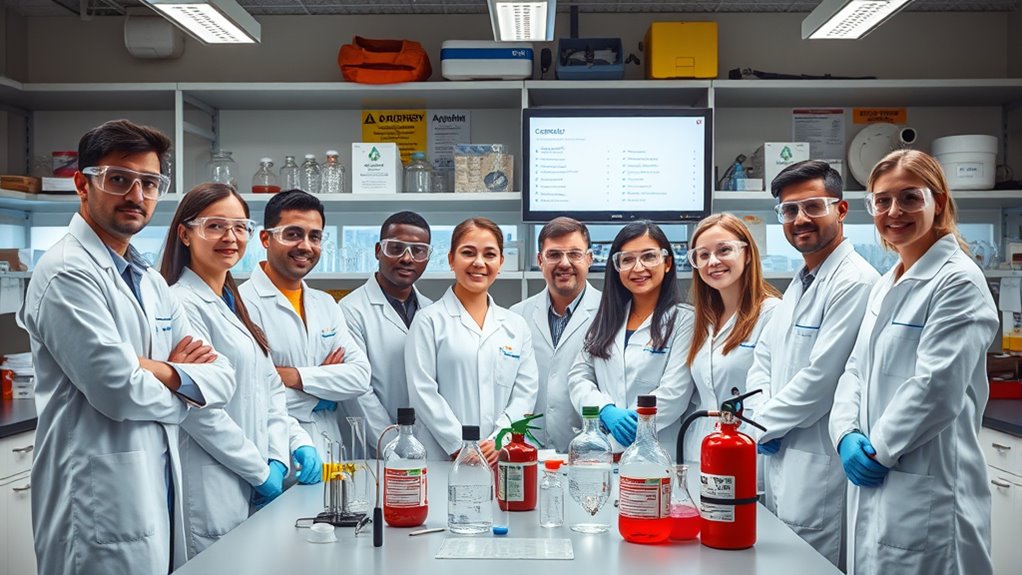
Creating a strong safety culture in the laboratory depends on clear leadership and shared accountability. You need management to actively support safety initiatives and define responsibilities through organizational charts.
Designated safety officers, like chemical hygiene officers, oversee safety programs, ensuring compliance with federal and state laws.
Regular education, safety training, workshops, and accessible resources keep everyone aware and prepared.
Promoting shared safety norms and encouraging peer reinforcement help embed safety as a core value.
Adhering to strict SOPs, conducting safety audits, and recognizing safe practices reinforce standards.
Proper facility design, regular equipment maintenance, and accessible PPE are essential.
Implement accountability measures like competency assessments and performance monitoring to ensure ongoing compliance.
Empowering all staff to speak up fosters a culture where safety is everyone’s priority.
Furthermore, staying informed about safety-related standards and best practices from reputable sources helps maintain high safety levels.
Frequently Asked Questions
How Can I Identify Hidden Hazards in the Lab Environment?
To identify hidden hazards in the lab, stay vigilant and actively observe your environment. Check for proper labeling, storage, and equipment conditions.
Be aware of less obvious risks like chemical vapors or biological contaminants. Conduct routine safety audits, communicate openly with colleagues about potential dangers, and monitor symptoms or unusual odors.
Using safety data sheets and following protocols helps uncover hazards that aren’t immediately visible, keeping everyone safer.
What Are the Most Common PPE Mistakes Students Make?
You often make PPE mistakes by not wearing the right gear or using it improperly. For example, you might neglect to wear safety glasses, reuse gloves, or wear ill-fitting masks.
Sometimes, you choose the wrong type of gloves for specific chemicals, or forget to check PPE for damage. These errors increase your risk of exposure, so always guarantee proper PPE selection, fit, and correct usage to stay safe during lab work.
How Do I Handle a Chemical Spill Safely?
Handling a chemical spill is like steering a storm; quick, calm action keeps everyone safe. First, identify the chemical’s hazards, then don your PPE to protect yourself.
Isolate the spill area, alert others, and follow your lab’s response procedures. Use appropriate cleanup tools and neutralizers, and dispose of contaminated materials properly.
What Should I Do if I Witness Unsafe Lab Behavior?
When you witness unsafe lab behavior, you should address it privately and respectfully to prevent embarrassment. Avoid ignoring it, and report the issue promptly to a supervisor or safety officer using established channels.
Encourage peer accountability and focus on safety impacts rather than personal criticisms. Document incidents when necessary, and follow up to make certain corrective actions are taken.
Promoting open communication helps maintain a safe and responsible lab environment.
How Often Should Safety Training Sessions Be Conducted?
You might think safety training is a one-and-done deal, but surprise—it’s actually ongoing! You should attend annual training sessions, especially if you’re working with hazardous materials.
New hires need initial training, and everyone should get refresher courses every three years or when duties change. Regular training keeps you alert, prepared, and compliant, preventing accidents.
Conclusion
By embracing essential safety practices, you create a confident, clean, and compliant climate. Prioritize preparedness, practice proper procedures, and promote a culture of caution and accountability. Remember, safety isn’t just a standard—it’s a vital responsibility that safeguards you, your colleagues, and your environment. Stay vigilant, vigilant, and vigilant again, because a safe space fosters success, surprises, and seamless scientific breakthroughs. Your commitment makes a pivotal difference—so stay safe, stay savvy!
